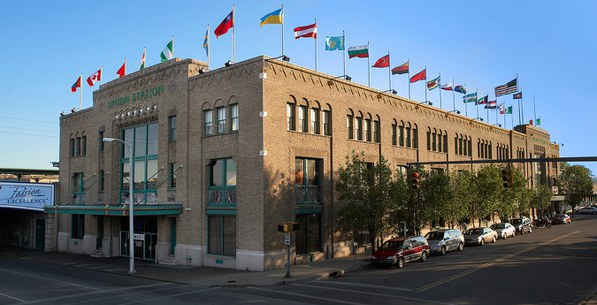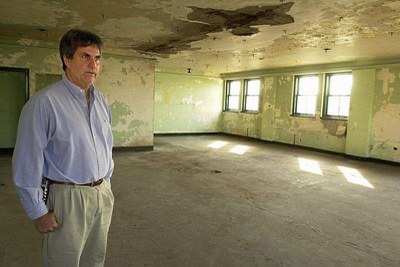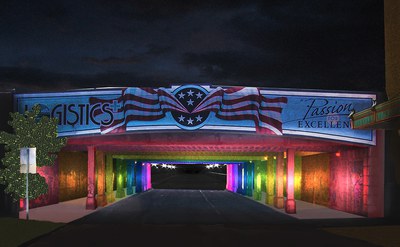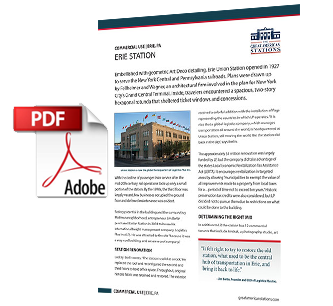Embellished with geometric Art Deco detailing, Erie Union Station opened in 1927 to serve the New York Central and Pennsylvania railroads.

Union Station is now the global headquarters of Logistics Plus Inc.
Plans were drawn up by Fellheimer and Wagner, an architectural firm involved in the plan for New York City’s Grand Central Terminal. Inside, travelers encountered a spacious, two-story hexagonal rotunda that sheltered ticket windows and concessions. With the decline of passenger train service after the mid-20th century, rail operations took up only a small portion of the station. By the 1970s, the third floor was largely vacant, few businesses occupied the ground floor and deferred maintenance was evident.
Seeing potential in the building and the surrounding Midtown neighborhood, entrepreneur Jim Berlin purchased Union Station in 2003 to house his international freight management company, Logistics Plus Inc (LP). He was attracted to the site “because it was a very cool building, and we are a cool company.”
Station Renovation

Logistics Plus Inc. founder Jim Berlin purchased the building in 2003 and subsequently renovated it to house his headquarters and other businesses.
Luckily, Berlin notes, “The station is solid as a rock.” He replaced the roof and reconfigured the second and third floors to hold office space. Throughout, original historic fabric was retained and restored. The exterior received a colorful addition with the installation of flags representing the countries in which LP operates. “It is nice that a global logistics company, which manages transportation all around the world, is headquartered at Union Station, still moving the world like the station did back in the day,” says Berlin.
The approximately $1 million renovation was largely funded by LP, but the company did take advantage of the state’s Local Economic Revitalization Tax Assistance Act (LERTA). It encourages revitalization in targeted areas by allowing “municipalities to exempt the value of all improvements made to a property from local taxes for a…period of time not to exceed ten years.” Historic preservation tax credits were also considered, but LP decided not to pursue them due to restrictions on what could be done to the building.
Determining the Right Mix
In addition to LP, the station has 12 commercial tenants that include Amtrak, a photography studio, art gallery, Mediterranean café, brewery and restaurant, engineering firm and hair salon. Approximately 60 percent of the 100,000 square feet of available space was leased as of summer 2015. LP directly manages the tenant leases and building maintenance rather than contracting these functions to a third party.
“It felt right to try to restore the old station, what used to be the central hub of transportation in Erie, and bring it back to life.”– Jim Berlin, Founder and CEO of Logistics Plus Inc.
Berlin originally thought the station might contain a railroad museum or a high-end steak house, but local demographics and market conditions helped shape the present commercial mix. He believes many business owners are attracted to the station due to ample parking and the neighborhood’s reputation as an up-and-coming area.
Chris Sirianni, owner of The Brewerie at Union Station, chose to locate his brew pub and restaurant there in 2006 because “people love old historic buildings, and it provided a casual space to grow into.” He also notes that the station’s high-capacity electric and water systems were able to accommodate his business needs without an expensive retrofit.
Anchoring the Neighborhood

Logistics Plus Inc. commissioned colorful murals for the rail viaduct adjacent to the station.
The station anchors the southern end of Midtown, a neighborhood subject to ongoing revitalization efforts that include improvements to Griswold Park and installation of new streetscaping by the city, rehabilitation of buildings such as the historic 1932 post office and development of infill housing. “I think…our ‘leap’ gave people hope that something could be done,” says Berlin. “Within a couple of more years this will be a completely different looking neighborhood than it was when we jumped in 11 years ago.” LP has also converted two nearby manufacturing buildings into warehouses and commissioned colorful murals for the rail viaduct that passes over the roads on both sides of the station.
Keys to Success
- LP renovated the station to suit modern office and commercial tenants
- Experimented with a tenant mix that responds to local market demands
- Station was one of the first large-scale building rehabilitation projects in Midtown
- LP continues to participate in wider efforts to support neighborhood redevelopment
- Renovation maintained the station’s historical integrity.
Thanks to Jim Berlin and Scott Frederick of Logistics Plus Inc. for their assistance; all images courtesy of LP.



 Amtrak established the Great American Stations Project in 2006 to educate communities on the benefits of redeveloping train stations, offer tools to community leaders to preserve their stations, and provide the appropriate Amtrak resources.
Amtrak established the Great American Stations Project in 2006 to educate communities on the benefits of redeveloping train stations, offer tools to community leaders to preserve their stations, and provide the appropriate Amtrak resources. For more than 50 years, Amtrak has connected America and modernized train travel. Offering a safe, environmentally efficient way to reach more than 500 destinations across 46 states and parts of Canada, Amtrak provides travelers with an experience that sets a new standard. Book travel, check train status, access your eTicket and more through the
For more than 50 years, Amtrak has connected America and modernized train travel. Offering a safe, environmentally efficient way to reach more than 500 destinations across 46 states and parts of Canada, Amtrak provides travelers with an experience that sets a new standard. Book travel, check train status, access your eTicket and more through the